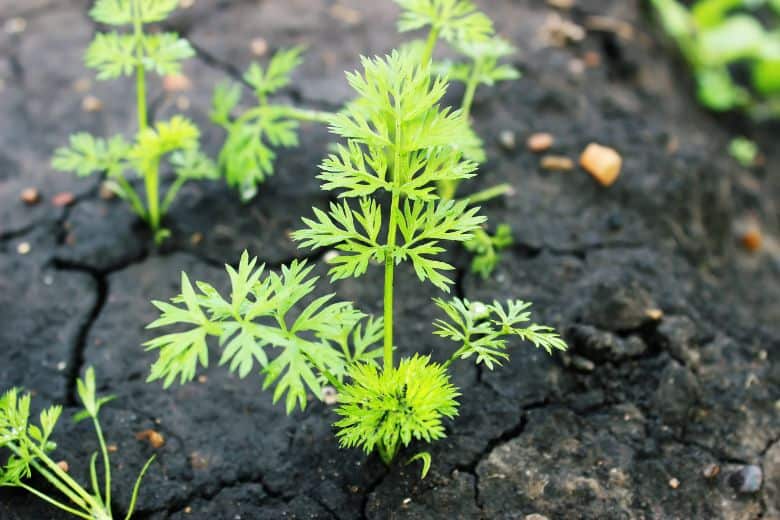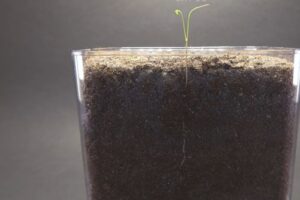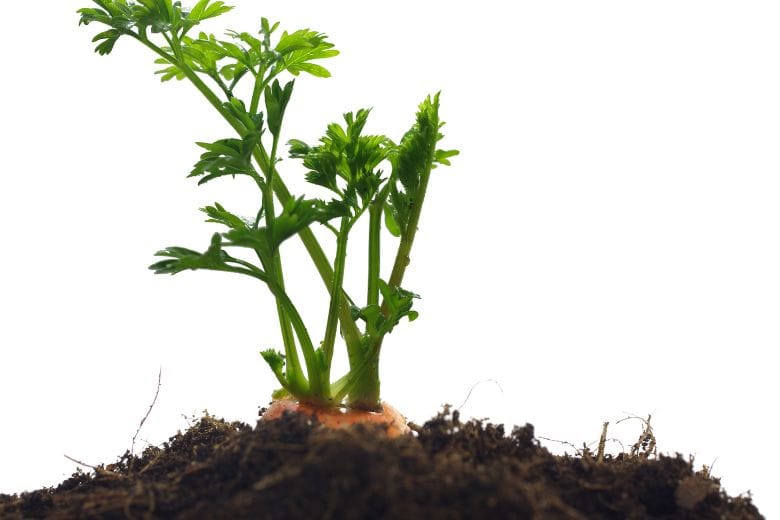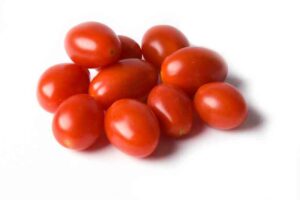
What Do Carrots Look Like When They Start Growing? Well, Carrots undergo several distinct growth stages as they develop from seeds planted in the ground. The first signs of life appear as tiny green sprouts emerge from the soil. These initial carrot seedlings have delicate feathery leaves arranged in a low-growing rosette pattern.
As the young carrot plants establish, they produce more leaves that expand to fill out the rosette. Meanwhile, below the soil surface, the first thin white carrot roots begin to elongate and swell.
Over several weeks, the carrot roots gradually put on size and thicken, lightening in color. Understanding the different appearances carrots have as they germinate, leaf out, and commence root formation gives gardeners confidence to nurture their crops every step of the way.
Young Carrot Stage
After the seedling stage, carrots enter the young carrot stage, where more rapid growth occurs. The feathery leaves will continue to grow and develop, reaching 4-6 inches in length. You will start to see a tiny whitish tail develop below the soil, which is the start of the carrot root. However, at this immature stage, the root is still very thin and delicate, only about the thickness of a lead pencil.
It is important not to pull on the plants at this stage to avoid damaging the tender taproot. The young carrot stage can last 4-6 weeks.
# Identification

- Leaves first emerge from the soil, thin and thread-like, about 1/4-1/2 inch long
- Bright green in color
- May appear singly or in clumps depending on planting density
- Check growth is coming from the planting area, not randomly scattered
- Leaves are smooth-edged without lobes or teeth like weeds
# Taproot

- May also see thin white hairlike taproots emerging if the soil is parted
- Gets thicker as the plant develops
- Seeing both leaves and taproot confirms carrot seedling
# Leaf Development

- Leave get longer and thicker, and develop characteristic carrot shape
- Mature leaves are hollow; rounded ends may have ridged edges
- Grow in a circular rosette pattern radiating from the central taproot
# Bud Formation

- After approximately 2 weeks, small buds form.
- Found between leaves and root crown
- Yellow and white flower buds, not yet open flowers
- Presence of buds along with foliage confirms carrot plant
Common Issues with Young Carrots
Unfortunately, young carrot plants are susceptible to some issues that may stunt or damage growth. Two common problems seen at the seedling and young carrot stages include:

1. Pulling or Damaged Roots
As mentioned, the tender seedling and young carrot roots are thin and easily broken. Pulling on foliage to inspect roots too early can sever roots. Proper gentle weeding and avoiding root disturbance helps.
2. Damping Off Disease
This fungal disease attacks seeds and seedlings, causing a rot at the soil line. It thrives in cool, wet conditions. Using fresh seed and a sterile starting medium in a sunny spot prevents this.
Addressing any potential problems early allows baby carrots the best chance to reach maturity. With an understanding of normal carrot germination and growth phases, gardeners are better equipped to identify and care for seedlings.
Established Juvenile Stage
After spending 4-6 weeks in the early carrot stage, plants enter the established juvenile phase, where more noticeable changes occur. Roots can now reach 1/2-1 inch in diameter and 4-6 inches in length below soil. Foliage matures into a full rosette pattern 6-10 inches wide. Roots remain thin yet stronger. This stage lasts 4-6 weeks as roots develop side branches in preparation for bulking up.
Conclusion
From a single seed emerges a delicate plant that must navigate several key growth phases before developing into a sizable root crop. With awareness of what young carrots look like as they sprout and are established, gardeners can provide optimal care. Observing normal development allows for any issues to be addressed promptly. Carrots may have a slow start, but with the right growing conditions can transform into a bountiful harvest with nutritional benefits. Understanding their journey from seed to table enhances our connection to the food we grow.







